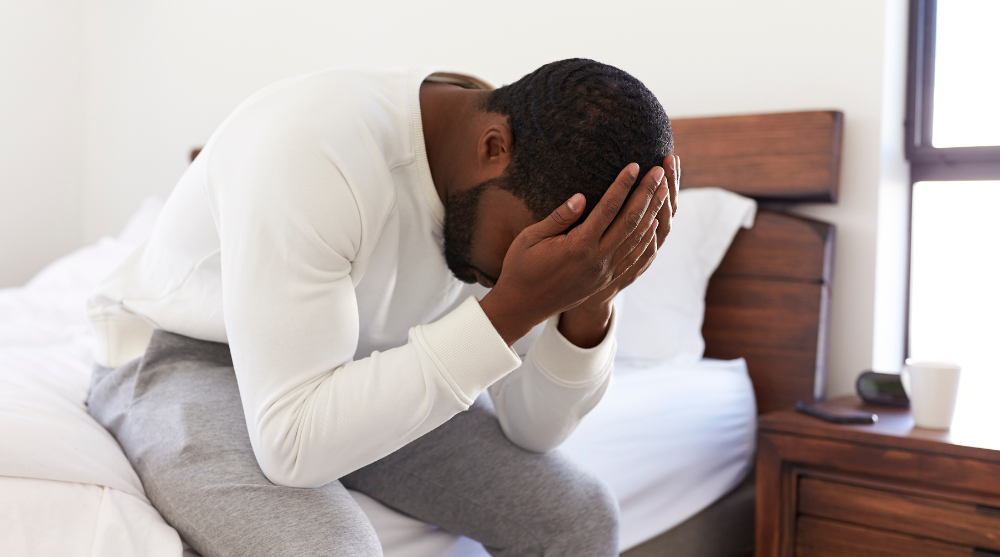Peyronie’s Disease
Move Better. Live Fuller. Your Wellness Journey Starts Here.
Schedule a FREE Discovery Call!
[rank_math_breadcrumb]
What Is Peyronie’s Disease?
Peyronie’s disease is a disorder characterized by penile curvature, which is created by a fibrous scar tissue called plaque. While penises vary in shape and size, and it is normal for someone to have a naturally curved penis, Peyronie’s disease creates a more serious curvature that can make erections or sex painful, and may cause erectile dysfunction. This condition may also cause pain in the penis even without an erection.
Peyronie’s disease creates a penile bend that may curve upward, downward, or to one side. The scar tissue (plaque) is able to be felt under the skin, and may feel like hard or bumpy tissue. When the penis is erect, it may be shorter than usual due to the harsh curving. Other symptoms may include:

- Being completely unable to have sex
- A change in the appearance of the penis
- A curve in the penis with or without an erection
- Stress or anxiety
This condition can present symptoms suddenly, or it may develop slowly over time. The symptoms and curvature can range widely, anywhere from mild to severe. Those with Peyronie’s disease don’t typically see their symptoms of pain or the curvature go away quickly without treatment, although the pain may subside after experiencing the condition long-term.
Early treatment of Peyronie’s disease is the best way to prevent the curvature from worsening over time, as well as prevent other dysfunctions from forming as a result of the condition. When Peyronie’s disease goes untreated for too long, the plaque may become very tough and fibrous, even forming calcium deposits (similar to bone). This plaque formation makes it more difficult to correct the curvature.
Although the pain may subside once the plaque growth stabilizes, individuals may still struggle with erectile dysfunction or other sexual dysfunctions due to the untreated curvature. Therefore, those who have had the condition long-term can often still benefit from treatment.
Sexual dysfunctions are worsened or caused by pelvic floor dysfunction, which can form as a result of the pain and discomfort experienced with Peyronie’s disease.
The pelvic floor is an important group of muscles that each and every person has in their pelvis (no matter your genitals). These muscles allow for urination, bowel movements, sexual function, and sexual appreciation. Sexual function allowed by the pelvic floor includes aspects such as arousal, erection, sensation, orgasm, and ejaculation. When these muscles are tight, inflexible, weak, or poorly coordinated, it leads to pelvic floor dysfunction.
Pelvic floor dysfunction affects the pelvic floor’s usual functions, causing individuals to experience pelvic pain, painful sex, erectile dysfunction, premature ejaculation, and more. As mentioned before, Peyronie’s disease is a contributor to pelvic floor dysfunction, and can be a cause of many sexual struggles. On the other hand, pelvic floor dysfunction can make the symptoms of Peyronie’s disease worse and more painful, meaning these two conditions can have a strong influence on one another.
Before we discuss treatment of pelvic floor dysfunction or sexual dysfunctions relating to Peyronie’s disease, let’s first discuss the possible causes of the condition’s extreme penile curvature…
What Causes Peyronie’s Disease?
The primary cause of Peyronie’s disease isn’t technically known, but research suggests it may be caused by repeated injury. This can be due to:
- Trauma or impact
- Sports injuries
- Frequent vigorous sex
These are thought to be causes of the condition because the curvature of the penis is created by a formation of internal scar tissue (plaque). Scar tissue typically forms as a healing response, and so injury or trauma to the penis is a likely cause.
Other causes such as autoimmune diseases, connective tissue diseases, genetics, and age can increase your risk of Peyronie’s disease. These aspects can all contribute to poor wound healing or a higher likelihood of plaque build-up. Having previous penile surgeries can increase your likelihood of the condition.
While there are some suggested causes of this condition, there are individuals who have the condition yet cannot recall any source of injury or impact. This means that the condition can be caused by a combination of factors, or factors that are not always related to injury.
So, how does the plaque cause curving and pain?
The penis has an internal structure called the tunica albuginea, which is an elastic membrane that helps keep the penis stiff during an erection. This membrane surrounds the tubes of the penis that contain blood vessels. Typically, as these tubes fill with blood during an erection, the elastic membrane will stretch with the growth of the penis.
However, when there is plaque concentrated to one area, it prevents a normal stretch of the membrane and creates a pulling effect to the surrounding tissue areas. This pulling creates the painful curvature that the condition is known for.
Those who experience Peyronie’s disease can engage in early treatment to prevent worsened curvature and symptoms. Patients in later stages of the condition can also find relief from pelvic floor dysfunction with treatment. We’ll talk about how pelvic floor physical therapy can be useful for both of these situations next!
Physical Therapy for Peyronie’s Disease
Treatment for Peyronie’s disease may require a multifaceted approach, involving urologists, sex therapists, and possibly mental health specialists. While pelvic floor therapy may not be the only treatment utilized for the condition, it plays an essential role in supporting pelvic floor health, sexual function, and sexual appreciation.
Your plan of care may vary depending on the severity of your symptoms from Peyronie’s disease and pelvic floor dysfunction. Additionally, the goals of physical therapy for this condition may differ slightly depending on what stage of Peyronie’s disease you are currently experiencing:
Early Stages of Peyronie’s Disease
The early or acute stages of Peyronie’s disease typically refer to when the curvature is still forming, and can be accompanied by pain, discomfort, and inflammation. Early treatment can stop and perhaps even reverse the curvature, as well as relieve your pain.
Physical therapy treatment during this stage seeks to:
- Improve flexibility and blood flow of the area, which will reduce the effects of Peyronie’s disease.
- Reduce pelvic floor tension, which can worsen pain and other symptoms of Peyronie’s disease.
- Improve pelvic floor strength, flexibility, and coordination to maintain sexual function and health.
- Prevent or treat symptoms of pelvic floor dysfunction.
Late Stage Peyronie’s Disease
Late stage Peyronie’s disease (also called the chronic phase) refers to when the curvature of the penis stabilizes and the pain has mostly subsided. This can be anywhere from a few months to a year since the start of the individual’s symptoms. The primary forms of treatment during this phase may include penile traction therapy, injections, or surgical corrections if necessary.
While pelvic floor physical therapy cannot necessarily remove the presence of the plaque that causes Peyronie’s disease, it can address pelvic floor dysfunction, pelvic pain from muscle tension, and sexual dysfunctions such as painful sex or erectile dysfunction. In severe cases that require other treatment methods such as surgery, physical therapy plays an essential supportive role.
Pelvic floor physical therapy for late stage Peyronie’s disease aims to:
- Provide better healing and recovery after surgery.
- Treat and reduce symptoms of pelvic floor dysfunction.
- Improve sexual health and function by improving pelvic floor health.
What Treatment May Look Like
Pelvic floor therapy for Peyronie’s disease involves treatments that improve the health and function of your pelvic floor, reduce pain and tension in the pelvis, and restore sexual function. Your physical therapist will work to treat and prevent pelvic floor dysfunction that may contribute to your symptoms or worsen the condition.
Treatment will begin with an evaluation, where your pelvic floor therapist discusses your symptoms and examines your pelvic floor health. Examination may be external or internal, but your physical therapist at Hive will never perform any exam or treatment without your consent. You are never required to provide consent to any service that you feel uncomfortable with, so you can rest easy in our clinic!
Once the evaluation is complete, your physical therapist will curate a treatment plan based on your needs. Treatments used in your care plan may include any of the following:
Manual Therapy
Manual therapy is a technique that manually manipulates tissue and mobilizes muscles, nerves, ligaments, and other structures that may be restricted or holding tension. This treatment can improve blood flow and reduce pain from muscle restrictions caused by tightness.
Manual treatments can be performed externally to your hips, abdominals, pelvis, and lower back—which are all areas that can create tension in the pelvic floor. This treatment can be performed internally to the pelvic floor via the rectum by utilizing pelvic wands or other tools.
Another manual technique that pelvic floor therapists are able to provide guidance for is penile traction therapy, a common manual treatment for the early stages of Peyronie’s disease. This treatment utilizes a non-surgical device that helps to gently stretch the penis in order to counteract the growing curvature from the condition.
Hive Therapy and Wellness always considers other treatments that you may be undergoing, and will work closely with your urologist in order to make sure your other treatments are not disrupted.
Hive’s pelvic floor therapists can even teach you penile stretching and massage that you can practice at home. This includes soft tissue manipulation to any area that is connected to the genitals and may hold tension—such as the pelvic floor muscles, lower abdomen, groin, mons pubis, testicles, and penis. Depending on your needs, you may learn penile stretching techniques such as the pin and stretch technique, which can play an important role in early treatment of Peyronie’s disease.
Lastly, your physical therapist can provide manual treatments such as cupping therapy on the surrounding areas to target tension and provide pain relief from Peyronie’s disease.
Pelvic Floor Training
To treat and prevent pelvic floor dysfunction, you will need to regain control and awareness of your pelvic floor (remember, it controls things like sexual functions, urination, and bowel movements). To regain your understanding and control of these essential muscles, your physical therapist will utilize treatments such as neuromuscular re-education and biofeedback.
These treatments will help you understand how the pelvic floor relaxes and contracts. By gaining an understanding of these functions and learning to voluntarily control them, you will be able to reduce tension and strengthen your pelvic floor.
Your physical therapist will be able to guide you through exercises and practices to improve your pelvic floor strength and coordination. Not only does having a strong pelvic floor prevent pelvic floor dysfunction, but it also allows for better sexual function and appreciation!
Pelvic floor training is especially important after any surgical corrections or implants involving the penis, as the pelvic floor shares many internal structures with the genitals. After these procedures, your pelvic floor will need extra care in order to restore its function and sensation.
Exercise Prescription
While exercising your pelvic floor is important, you should balance the muscles in the rest of your body, too. As mentioned before, your hips, abdominals, lower back, and other areas of the body can affect your pelvic floor; so balancing these areas is very important. A curated exercise routine can improve your flexibility, blood flow, and general health necessary to support sexual function.
Behavioral Modifications
It is often necessary to make lifestyle changes in order to prevent the effects of Peyronie’s disease or the likelihood of pelvic floor dysfunction.
Potential causes of Peyronie’s disease are suggested to be repeated stressors or trauma. Altering or stopping the root of these causes (vigorous sex or masturbation, high intensity sports, or certain exercises) may be necessary.
Pelvic floor dysfunction can be caused by a variety of factors. Not only does the pain from Peyronie’s disease contribute to it, but many other daily habits can create tension in your pelvic floor, too. Therefore, your physical therapist will make sure to address your posture, bathroom habits, and other common contributors.
Education
Lastly, your pelvic floor therapist can provide a wealth of information to support your treatment. Not only can they help you better understand bodily anatomy or other conditions that may be present alongside Peyronie’s (such as erectile dysfunction), but they can also provide instruction for at-home care, such as the manual therapies described previously. At-home care can include relaxation techniques that reduce pelvic floor tension, anxiety, and stress.
Your physical therapist can suggest different positions that could improve physical comfort during sexual activity. This is especially helpful for individuals who have reached the later stages of Peyronie’s disease, but either choose not to undergo or cannot undergo surgery. Your pelvic floor therapist can suggest positions based on your unique penile curvature that will make sexual activity more comfortable for both you and your partner. Remember, there’s no shame in seeking better sexual health!
As you can see, there are plenty of ways that a pelvic floor physical therapist can address Peyronie’s disease and its symptoms. The physical therapists at Hive Therapy and Wellness understand that this condition can vary from person to person, and will curate a treatment plan based on your unique needs. Hive’s physical therapists work hard to provide a holistic and comprehensive treatment experience, so your treatment plan could include any of the following:
- Neuromuscular re-education
- Manual therapy
- Exercise prescription
- Dry needling
- Cupping
- Tissue scraping
- Behavioral modifications
- Therapeutic activities
- Electrical muscle stimulation
- Spinal manipulation
- Therapeutic modalities
- Biofeedback
Peyronie’s disease is a disorder characterized by penile curvature, which is created by a fibrous scar tissue called plaque.
While penises vary in shape and size, and it is normal for someone to have a naturally curved penis, Peyronie’s disease creates a more serious curvature that can make erections or sex painful, and may cause erectile dysfunction.
This condition may also cause pain in the penis even without an erection.
Peyronie’s disease creates a penile bend that may curve upward, downward, or to one side. The scar tissue (plaque) is able to be felt under the skin, and may feel like hard or bumpy tissue.
When the penis is erect, it may be shorter than usual due to the harsh curving. Other symptoms may include:
- Being completely unable to have sex
- A change in the appearance of the penis
- A curve in the penis with or without an erection
- Stress or anxiety
This condition can present symptoms suddenly, or it may develop slowly over time. The symptoms and curvature can range widely, anywhere from mild to severe.
Those with Peyronie’s disease don’t typically see their symptoms of pain or the curvature go away quickly without treatment, although the pain may subside after experiencing the condition long-term.
Early treatment of Peyronie’s disease is the best way to prevent the curvature from worsening over time, as well as prevent other dysfunctions from forming as a result of the condition.
When Peyronie’s disease goes untreated for too long, the plaque may become very tough and fibrous, even forming calcium deposits (similar to bone). This plaque formation makes it more difficult to correct the curvature.
Although the pain may subside once the plaque growth stabilizes, individuals may still struggle with erectile dysfunction or other sexual dysfunctions due to the untreated curvature. Therefore, those who have had the condition long-term can often still benefit from treatment.
Sexual dysfunctions are worsened or caused by pelvic floor dysfunction, which can form as a result of the pain and discomfort experienced with Peyronie’s disease.
The pelvic floor is an important group of muscles that each and every person has in their pelvis (no matter your genitals). These muscles allow for urination, bowel movements, sexual function, and sexual appreciation.
Sexual function allowed by the pelvic floor includes aspects such as arousal, erection, sensation, orgasm, and ejaculation. When these muscles are tight, inflexible, weak, or poorly coordinated, it leads to pelvic floor dysfunction.
Pelvic floor dysfunction affects the pelvic floor’s usual functions, causing individuals to experience pelvic pain, painful sex, erectile dysfunction, premature ejaculation, and more.
As mentioned before, Peyronie’s disease is a contributor to pelvic floor dysfunction, and can be a cause of many sexual struggles. On the other hand, pelvic floor dysfunction can make the symptoms of Peyronie’s disease worse and more painful, meaning these two conditions can have a strong influence on one another.
Before we discuss treatment of pelvic floor dysfunction or sexual dysfunctions relating to Peyronie’s disease, let’s first discuss the possible causes of the condition’s extreme penile curvature…
The primary cause of Peyronie’s disease isn’t technically known, but research suggests it may be caused by repeated injury. This can be due to:
- Trauma or impact
- Sports injuries
- Frequent vigorous sex
These are thought to be causes of the condition because the curvature of the penis is created by a formation of internal scar tissue (plaque). Scar tissue typically forms as a healing response, and so injury or trauma to the penis is a likely cause.
Other causes such as autoimmune diseases, connective tissue diseases, genetics, and age can increase your risk of Peyronie’s disease.
These aspects can all contribute to poor wound healing or a higher likelihood of plaque build-up. Having previous penile surgeries can increase your likelihood of the condition.
While there are some suggested causes of this condition, there are individuals who have the condition yet cannot recall any source of injury or impact.
Additionally, not every person who has experienced an impact to the penis ends up with Peyronie’s disease. This means that the condition can be caused by a combination of factors, or factors that are not always related to injury.
So, how does the plaque cause curving and pain?
The penis has an internal structure called the tunica albuginea, which is an elastic membrane that helps keep the penis stiff during an erection. This membrane surrounds the tubes of the penis that contain blood vessels.
Typically, as these tubes fill with blood during an erection, the elastic membrane will stretch with the growth of the penis.
However, when there is plaque concentrated to one area, it prevents a normal stretch of the membrane and creates a pulling effect to the surrounding tissue areas. This pulling creates the painful curvature that the condition is known for.
Those who experience Peyronie’s disease can engage in early treatment to prevent worsened curvature and symptoms. Patients in later stages of the condition can also find relief from pelvic floor dysfunction with treatment.
We’ll talk about how pelvic floor physical therapy can be useful for both of these situations next!
Treatment for Peyronie’s disease may require a multifaceted approach, involving urologists, sex therapists, and possibly mental health specialists.
While pelvic floor therapy may not be the only treatment utilized for the condition, it plays an essential role in supporting pelvic floor health, sexual function, and sexual appreciation.
Your plan of care may vary depending on the severity of your symptoms from Peyronie’s disease and pelvic floor dysfunction.
Additionally, the goals of physical therapy for this condition may differ slightly depending on what stage of Peyronie’s disease you are currently experiencing:
Early Stages of Peyronie’s Disease
The early or acute stages of Peyronie’s disease typically refer to when the curvature is still forming, and can be accompanied by pain, discomfort, and inflammation.
Early treatment can stop and perhaps even reverse the curvature, as well as relieve your pain.
Physical therapy treatment during this stage seeks to:
- Improve flexibility and blood flow of the area, which will reduce the effects of Peyronie’s disease.
- Reduce pelvic floor tension, which can worsen pain and other symptoms of Peyronie’s disease.
- Improve pelvic floor strength, flexibility, and coordination to maintain sexual function and health.
- Prevent or treat symptoms of pelvic floor dysfunction.
Late Stage Peyronie’s Disease
Late stage Peyronie’s disease (also called the chronic phase) refers to when the curvature of the penis stabilizes and the pain has mostly subsided.
This can be anywhere from a few months to a year since the start of the individual’s symptoms. The primary forms of treatment during this phase may include penile traction therapy, injections, or surgical corrections if necessary.
While pelvic floor physical therapy cannot necessarily remove the presence of the plaque that causes Peyronie’s disease, it can address pelvic floor dysfunction, pelvic pain from muscle tension, and sexual dysfunctions such as painful sex or erectile dysfunction.
In severe cases that require other treatment methods such as surgery, physical therapy plays an essential supportive role.
Pelvic floor physical therapy for late stage Peyronie’s disease aims to:
- Provide better healing and recovery after surgery.
- Treat and reduce symptoms of pelvic floor dysfunction.
- Improve sexual health and function by improving pelvic floor health.
What Treatment May Look Like
Pelvic floor therapy for Peyronie’s disease involves treatments that improve the health and function of your pelvic floor, reduce pain and tension in the pelvis, and restore sexual function.
Your physical therapist will work to treat and prevent pelvic floor dysfunction that may contribute to your symptoms or worsen the condition.
Treatment will begin with an evaluation, where your pelvic floor therapist discusses your symptoms and examines your pelvic floor health. Examination may be external or internal, but your physical therapist at Hive will never perform any exam or treatment without your consent.
You are never required to provide consent to any service that you feel uncomfortable with, so you can rest easy in our clinic!
Once the evaluation is complete, your physical therapist will curate a treatment plan based on your needs. Treatments used in your care plan may include any of the following:
Manual Therapy
Manual therapy is a technique that manually manipulates tissue and mobilizes muscles, nerves, ligaments, and other structures that may be restricted or holding tension.
This treatment can improve blood flow and reduce pain from muscle restrictions caused by tightness.
Manual treatments can be performed externally to your hips, abdominals, pelvis, and lower back—which are all areas that can create tension in the pelvic floor.
This treatment can be performed internally to the pelvic floor via the rectum by utilizing pelvic wands or other tools.
Another manual technique that pelvic floor therapists are able to provide guidance for is penile traction therapy, a common manual treatment for the early stages of Peyronie’s disease.
This treatment utilizes a non-surgical device that helps to gently stretch the penis in order to counteract the growing curvature from the condition.
Hive Therapy and Wellness always considers other treatments that you may be undergoing, and will work closely with your urologist in order to make sure your other treatments are not disrupted.
Hive’s pelvic floor therapists can even teach you penile stretching and massage that you can practice at home. This includes soft tissue manipulation to any area that is connected to the genitals and may hold tension—such as the pelvic floor muscles, lower abdomen, groin, mons pubis, testicles, and penis.
Depending on your needs, you may learn penile stretching techniques such as the pin and stretch technique, which can play an important role in early treatment of Peyronie’s disease.
Lastly, your physical therapist can provide manual treatments such as cupping therapy on the surrounding areas to target tension and provide pain relief from Peyronie’s disease.
Pelvic Floor Training
To treat and prevent pelvic floor dysfunction, you will need to regain control and awareness of your pelvic floor (remember, it controls things like sexual functions, urination, and bowel movements).
To regain your understanding and control of these essential muscles, your physical therapist will utilize treatments such as neuromuscular re-education and biofeedback.
These treatments will help you understand how the pelvic floor relaxes and contracts. By gaining an understanding of these functions and learning to voluntarily control them, you will be able to reduce tension and strengthen your pelvic floor.
Your physical therapist will be able to guide you through exercises and practices to improve your pelvic floor strength and coordination. Not only does having a strong pelvic floor prevent pelvic floor dysfunction, but it also allows for better sexual function and appreciation!
Pelvic floor training is especially important after any surgical corrections or implants involving the penis, as the pelvic floor shares many internal structures with the genitals.
After these procedures, your pelvic floor will need extra care in order to restore its function and sensation.
Exercise Prescription
While exercising your pelvic floor is important, you should balance the muscles in the rest of your body, too.
As mentioned before, your hips, abdominals, lower back, and other areas of the body can affect your pelvic floor; so balancing these areas is very important.
A curated exercise routine can improve your flexibility, blood flow, and general health necessary to support sexual function.
Behavioral Modifications
It is often necessary to make lifestyle changes in order to prevent the effects of Peyronie’s disease or the likelihood of pelvic floor dysfunction.
Potential causes of Peyronie’s disease are suggested to be repeated stressors or trauma. Altering or stopping the root of these causes (vigorous sex or masturbation, high intensity sports, or certain exercises) may be necessary.
Pelvic floor dysfunction can be caused by a variety of factors. Not only does the pain from Peyronie’s disease contribute to it, but many other daily habits can create tension in your pelvic floor, too.
Therefore, your physical therapist will make sure to address your posture, bathroom habits, and other common contributors.
Education
Lastly, your pelvic floor therapist can provide a wealth of information to support your treatment.
Not only can they help you better understand bodily anatomy or other conditions that may be present alongside Peyronie’s (such as erectile dysfunction), but they can also provide instruction for at-home care, such as the manual therapies described previously.
At-home care can include relaxation techniques that reduce pelvic floor tension, anxiety, and stress.
Your physical therapist can suggest different positions that could improve physical comfort during sexual activity. This is especially helpful for individuals who have reached the later stages of Peyronie’s disease, but either choose not to undergo or cannot undergo surgery.
Your pelvic floor therapist can suggest positions based on your unique penile curvature that will make sexual activity more comfortable for both you and your partner. Remember, there’s no shame in seeking better sexual health!
As you can see, there are plenty of ways that a pelvic floor physical therapist can address Peyronie’s disease and its symptoms.
The physical therapists at Hive Therapy and Wellness understand that this condition can vary from person to person, and will curate a treatment plan based on your unique needs.
Hive’s physical therapists work hard to provide a holistic and comprehensive treatment experience, so your treatment plan could include any of the following:
- Neuromuscular re-education
- Manual therapy
- Exercise prescription
- Dry needling
- Cupping
- Tissue scraping
- Behavioral modifications
- Therapeutic activities
- Electrical muscle stimulation
- Spinal manipulation
- Therapeutic modalities
- Biofeedback
You can learn more about these treatments on our Treatments Page.





